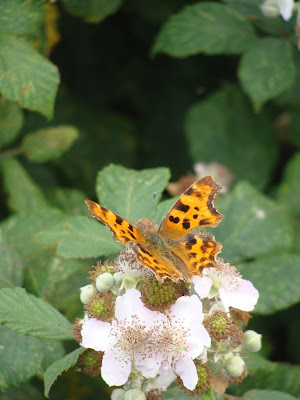 |
| Mud: they love it, you love it. Cliffe Pools, 21/7/13 |
Despite earning some unfortunate tshirt tan lines on a sweltering walk round Cliffe yesterday, there were hints of cooler climes with a smattering of new arrivals from their northern breeding grounds. A nice summer plumaged Knot bobbing amongst the common terns on islands at the back of Conoco had me thinking Curlew Sandpiper for a moment but a better look confirmed otherwise. I like this time of year, having to get wader brain on again, ready for those birds in summer dress or moult, usually more conspicuous here in their muted tones of winter.
On Flamingo beach a good flock of 16 Whimbrel roosted amidst the sea of Shelduck that have been busy at Cliffe this season. Over the Thames Viewpoint, five juveniles took one of their first trips out, accompanied by an adult. The river was flat calm, seemingly stuck to the sky, with a faint easterly as comforting as a stranger's hot breath on your neck on a rush-hour tube.
Down the back track two Yellow wagtails flew over and instantly disappeared into the coarse, bleached rough of the coastguard paddocks. Two Pied wagtails sparred energetically. I love this part of the reserve, the view is one of Hoo's best, several miles of marshes and grassland stretching east, pocked with livestock, ditches and forgotten barns, parched in this heat but still buzzing:
 |
| View east from Cliffe Pools, 21/7/13 |
If Boris and those other soulless crones had their way, everything in the photo above, bar a thin sliver in the foreground, would be tarmac and fences.
Seven Oystercatchers on the jetty, two adult Common gulls looked hot.
I spent a while by Black Barns 1 & 2 but despite some muddy fringes appearing, the levels on the pools are still too high for most waders. A handful of hazy shapes on 4 could be picked out by squinting and refocusing; one or two Greenshank among godwits and lapwings. One or two eclipse Shoveler lurked in the reeds too and a healthy brood of Tufted ducks formed a queue behind their parents. In the top corner of Radar, a gathering of 12 roosting Greenshank were punctuated by a single small wader which turned out to be a nice summer Sanderling. I can't remember the last time I saw one so neat. A Green Sandpiper flew over and several Little egrets probed and preened in the shallows - making it look like a good day to be an egret.
Round at the Radar viewpoint I bumped into a birder who put me onto a Turnstone, another bird I associate more with winter on the estuary than anything. A large flock of brick-red Black-tailed godwits roosted on one the main causeway, alongside Redshank, Lapwing, Greylag geese and more Greenshank. As an annoying microlight flew low over the reserve, the whole lot pitched up and wheeled about, revealing the huge, previously hidden flock of Avocet behind. With the numbers present it was like an unseasonal snowstorm had descended, only to melt away in a flash.
The final wader action came in the form of several Dunlin on Radar, while a check along the rear of the causeway from the Saxon Shore Way eventually turned up a Spotted Redshank. This one wasn't quite suited up so was perhaps a non-breeder, still, a nice looking bird. A pretty good haul, things are hotting up...
 |
| Six-spot Burnet on Ragwort |
 |
| Comma on brambles |
 |
| No Estuary Airport |
























